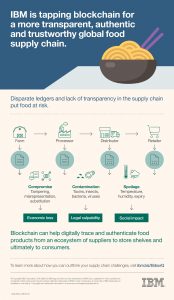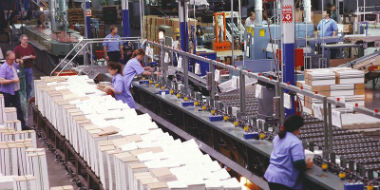Blockchain
Blockchain’s Role in Improving Global Food Safety
October 19, 2016 | Written by: Bridget van Kralingen
Categorized: Blockchain
Share this post:
The focus on safety throughout the global food supply chain is at an all-time high, for all the wrong reasons. The numbers of people sickened by contaminated food products continues to escalate and recalls are issued with increasing frequency.
Like virtually every other complex issue in a world dominated by data and how it’s used, the complex “system of systems” that is our global network of food production, inspection and distribution is primed for improvement via more open, transparent and fluid handling of information at every point in the journey from field to fork.
Food authentication and supply chain tracking is a critical step in quickly finding and helping address sources of contamination around the world. Blockchain presents an innovative new way to work toward achieving these goals. (Credit: IBM)
It’s high time. According to the World Health Organization, an estimated 600 million –- almost 1 in 10 people in the world –- fall ill after eating contaminated food every year, and 420,000 of them die — resulting in the subtraction of 33 million healthy life years from global societies and economies. The cost to individual lives is not the only substantial expense of foodborne illnesses.
In a recent study the estimated total national cost in the U.S. has spiked to $93.2 billion a year, an astounding increase of almost 20 percent in just the last four years. One looming issue in food safety is its provenance, which has minimal existing technology used to track food from the farm to plates.
To supply the world with millions of pounds of food, much of it must pass through many people, organizations, and governments that cultivate, influence or audit how it arrives to consumers. Collaboration and trust between governments, producers and suppliers is needed to re-establish consumers’ faith in the global food supply chain.
In a recent survey, 68 percent of consumers in the U.S. said they are not provided with enough information about what is in their food and its origins. More than 90 percent of consumers reported it is somewhat or very important to know where their food is coming from. IBM is leveraging blockchain to make the global food chain more transparent, authentic and trustworthy. Blockchain is like a computer’s operating system, regulating interactions and because it creates an immutable digital record of these transactions, it is ideal for tracing the safety and authenticity of goods as they move from food suppliers to store shelves and consumers.
A recent IBM Institute for Business Value (IBV) study on blockchain in the supply chain found by digitally tracking the provenance and movement of food throughout the entire supply chain, purveyors have instant quality assurance that the products they receive and serve customers are safe. With blockchain, this information flow can be widely shared to enhance decisions at all levels of the supply chain.
For example, “ready to eat” foods – such as frozen lasagna – top the list for recalled food products by a wide margin because they involve a large supply chain with multiple parties. Ready-to-eat food, once processed, typically requires a third party such as a logistics provider to transport the food to distribution warehouses.
Sometimes another supply chain partner provides this service and then often another intermediary provider will deliver the food from the warehouse to the store. That’s not only expensive, but maintaining the quality standards set by regulators by the USDA to keep perishable products safe is also a challenge, particularly when the product contains frozen meat, vegetables or milk products.
Putting this transaction record on the blockchain can create significant savings in time, cost and transparency. Blockchain can transparently track the provenance of goods as they are passed from one organization to the next, building awareness and trust.
Scientists from IBM Research and researchers from Tsinghua University are working alongside top talent in transaction security and authentication technology from Tsinghua University and with Walmart’s expertise in supply chain, logistics and food safety, to create a new model for food traceability, supply chain transparency and auditability using IBM Blockchain based on the open source Linux Foundation Hyperledger Project fabric.
The collaboration of Walmart, IBM and Tsinghua University takes advantage of the distinctive strengths of each member of the team. Scientists from IBM Research – China are among the leading edge technologists at IBM now in the forefront of the rapid evolution of blockchain. This can help retailers like Walmart better supervise and manage the shelf life of products and reduce the risk of non-compliance in individual stores, ensuring that consumers are getting authenticated, safe products. Which is exactly the answer required.

Senior Vice President, Global Markets, and Senior Executive Sponsor of the LGBT+ community at IBM
How Data and Analytics Can Power a Transformation in Long-Term Disability
Employer-provided disability insurance has a problem — it’s reactive, risk-based payout, and in its current state, it cannot affect the metrics employers and employees truly care about: employee engagement, productivity and wellness. Modern disability insurance first became available in the late 19th century and was called “accident insurance.” It was meant to protect workers in […]
Bringing Blockchain to Healthcare for a New View on Data
In a complex health system, seamless transitions in care are dependent upon, and often hindered by, the ability to access and share patient data. In a new proof of concept at Canada’s University Health Network (UHN), blockchain is being used to create a new model in which health data can be rapidly unlocked by authorized […]
Bringing AI and Blockchain to Bear on Environmental Challenges
IBM began focusing on environmental sustainability before the first Earth Day was ever celebrated. Addressing environmental challenges requires sustained action because even as we make progress, new challenges emerge. The digital transformation of our business and our clients’ businesses is improving the degree to which we can both examine and address global environmental challenges. Today, […]



